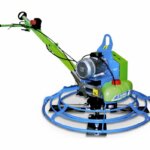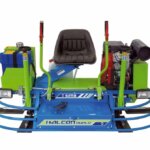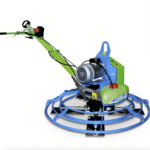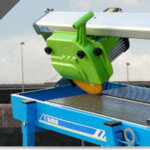Power trowels are a key piece of equipment for anyone who regularly pours medium to large slabs of concrete. Also known as helicopters or power floats, power trowels are used while freshly poured concrete is still partially wet to make it perfectly flat and even and give it a smooth, professional finish. There are two different types of power trowels, walk-behind and ride-on. Ride-on power trowels are generally only used for extremely large, commercial concrete pours for which a walk-behind machine would be impractical. Because a walk-behind power trowel is sufficient for most consumers and professionals, SIMA carries several models of walk-behind power trowels. Nevertheless, safety, cleaning and maintenance of your power trowel is roughly the same whether it is a ride-on or walk-behind machine.
Contents
Safety tips for using your power trowel
Safety is everyone’s number one priority, from beginners to professionals. Before using your power trowel for the first time, it’s a good idea to read through the instruction manual. As not all machines are the same, this will ensure that you use the machine safely and will also give you better results. If you have never used this type of machine before, consult someone who has experience with power trowels before trying it for yourself.
And of course, make sure you wear the appropriate shoes, clothing and personal protective gear when using your power trowel. Construction boots, a helmet, eye and ear protection should be worn at all times, and clothing should not be too loose. If you have problems with your neck or back, consult your doctor and take care when pushing the walk-behind machine.
Always inspect your power trowel for wear and damaged parts before each use.
Cleaning and maintenance of your power trowel
It’s extremely important to clean all of the concrete off your power trowel as soon as you are finished with the machine for the day.
When using the power trowel, you should apply concrete release agent to the appropriate areas, grease the trowel arms, check the air filter, check the oil level, check belts for wear and proper tension, and do a visual inspection for damage, wear, loose bolts, etc. on a daily basis.
After approximately 50 hours of use, you should check and adjust the valve clearance on your power trowel’s engine, as well as the drive belts.
After approximately 100 hours of use, you should change the oil in your power trowel and replace the oil filter. After approximately 300 hours of use, you should replace the fuel filter (not necessary if using an electric power trowel) and the spark plugs.
Transporting your power trowel
SIMA walk-behind power trowels are designed to be compact and easy to transport. It is very important that you transport your power trowel carefully from storage to job site. Most of the time, any damage to a power trowel is caused during transportation from one site to another because proper precautions were not taken. Make sure the machine is secure during transport and always inspect the power trowel before using it once it has arrived at the job site.





